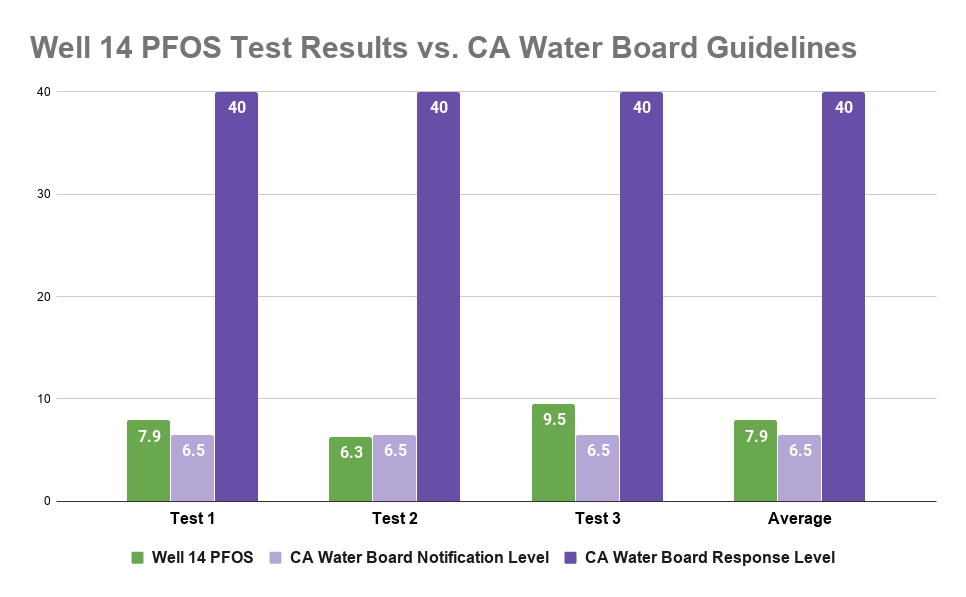Background & Timeline
PFAS (per- and poly-flouroalkyl substances) are a large group of man-made substances that includes PFOS (perflourooctanesulfonate), PFOA (perflouroctanoate) and other chemicals. They are commonly found in consumer and industrial products, such as carpets, rugs, waterproof clothing, upholstery, food paper wrappings, non-stick products (e.g., cookware) fire-fighting foams, and metal products. High concentrations of PFAS are believed to cause adverse health effects, including developmental effects to fetuses during pregnancy or to breastfed infants, cancer, liver effects, immune effects, thyroid effects and high cholesterol.
While there is no U.S. EPA Maximum Contaminant Level that would set a legal threshold for the amount safely allowed in drinking water, the State of California has established notification levels (NL) and response levels (RL) for PFOA and PFOS.
| wdt_ID | Water Terms |
|---|---|
| 1 | The Notification Level (NL) means that the concentration level of a contaminant in drinking water delivered for human consumption does not pose a significant health risk but warrants notification. |
| 2 | The Response Level (RL), when exceeded, requires further action recommended by the State Water Resources Control Board to reduce public exposure to the compound, by either removal of the source water from service, or providing treatment of that water. |
| 3 | The unit part per trillion (ppt) equates to one drop of water in 20 olympic size swimming pools put together; one drop of water in 42 million gallons of water; or one drop of water in a lake. |
The State Water Resources Control Board updated the notification levels in August 2019 and response levels in February 2020 to the following:
| wdt_ID | Substance | Notification Level | Response Level |
|---|---|---|---|
| 1 | PFOA | 5.1 ppt | 10 ppt |
| 2 | PFOS | 6.5 ppt | 40 ppt |
Testing for these chemicals in water started in 2013 when all California cities were required to test. The results from that testing found that Paramount’s water was “non-detect” for PFOS/PFOA.
PFAS Testing
Following the State’s announcement of updated notification level and response level for PFOS/PFOA, the City of Paramount voluntarily tested its wells for the substances. Water testing completed on February 3, 2020, and confirmed February 27, 2020, and April 6, 2020, indicate levels of PFOS that are above the State of California’s notification level. Results detected PFOS in one of the City’s three municipal wells, Well 14, at an average level of 7.9 parts per trillion (ppt) — slightly above the NL of 6.5 ppt and well below the response level of 40 ppt.
| wdt_ID | Well 14 | Test Date | Test Results Received | PFOS - perfluorooctanesulfonate (Parts Per Trillion) | PFOA - perfluorooctanoate (Parts Per Trillion) | Combined Parts Per Trillion |
|---|---|---|---|---|---|---|
| 1 | Test 1 | 2/3/20 | 2/19/20 | 7.9 | ND | 7.9 |
| 3 | Test 2 | 2/27/20 | 3/22/20 | 6.3 | ND | 6.3 |
| 4 | Test 3 | 4/6/20 | 4/20/20 | 9.5 | ND | 9.5 |
| 5 | Average | - | - | 7.9 | ND | 7.8 |
Although not required to do so, the City voluntarily shut down Well 14 on February 20, 2020, while awaiting the confirmation test results, and the well continues to be offline. The City has taken the opportunity to complete required preventive maintenance on the well.
The City of Paramount now conducts quarterly testing for PFOS for Well 14, while exploring potential treatment systems. The test results for the quarterly sampling are posted to the Water Reports & Test Results page.
As part of the City’s quarterly testing of Well 14 for PFAS constituents, sampling data collected on July 12, 2021 indicated PFOS levels of 10 parts per trillion (ppt). This is slightly elevated from previous testing of Well 14 that averaged about 7.6 ppt. Although the State of California’s response level is 40 ppt, the City voluntarily took Well 14 offline on February 20, 2020. Well 14 will remain offline and the City will continue to test on a quarterly basis within acceptable standards set forth by the State Water Resources Control Board.
In September 2021, the City opted to voluntarily test Well 16 (the City’s newest water well, currently under development) for all compounds within the PFAS family, including PFOA, PFOS and 16 others. The results for this new, high capacity well came back Non Detect (ND) for these compounds.
The City continues to provide safe, healthy reliable drinking water to residents through well 15 and additional imported water sources.
Golden State Water Company PFAS Findings
In December 2020, the City of Paramount received a notification from Golden State Water Company (GSW) stating that a GSW well serving a portion of the City of Paramount had detections of Perfluorooctanesulfonic Acid (PFOS) and Perfluorooctanoic Acid (PFOA) during their routine testing. The levels were found at the McKinley Well 3 location which serves portions of Paramount as well as South Gate. Click here to view a map of the portion of Paramount served by GSW.
Each test result of the McKinley Well 3 location has exceeded the Notification level, but remain below the Response Levels. Click here to view a letter detailing the test results.
For more information, visit GSW’s website: www.gswater.com
Frequently Asked Questions
Yes, Paramount’s water quality meets or surpasses all state and federal standards. Although we are not required, Well 14 has been voluntarily taken offline. We are meeting water demands with water from Wells 13 and Well 15, which both tested non-detect for PFAS. We are also supplementing with imported water from the Metropolitan Water District of Southern California (MWD). Our staff is dedicated to ensuring that every customer’s water is up to or above health standards. PFAS is a nationwide issue and Paramount will continue to remain proactive in its mitigation efforts.
Per- and polyfluoroalkyl substances (PFAS) are a large group of human-made substances that do not occur naturally in the environment and are resistant to heat, water, and oil. PFAS have been used extensively in surface coating and protectant formulations due to their unique ability to reduce the surface tension of liquids. Perfluorooctane sulfonic acid (PFOS) and perfluorooctanoic acid (PFOA) are two types of PFAS that are no longer manufactured or imported into the United States; however, there could be some imported goods containing trace amounts of these substances.
PFAS are persistent in the environment and can accumulate within the human body over time. Exposure to unsafe levels of PFOA/PFOS may result in adverse health effects including developmental effects to fetuses during pregnancy, cancer, liver effects, immune effects, thyroid effects, and other effects (such as cholesterol changes). PFOA and PFOS were found in the blood of nearly all people tested in several national surveys. According to the Center for Disease Control (CDC), blood levels of both PFOS and PFOA have steadily decreased in U.S. residents since 1999-2000.
https://www.waterboards.ca.gov/pfas/docs/master_pfas_faq_mar.pdf
Testing for PFAS in water started in 2013 when all California cities were required to test. The results from that testing found that Paramount’s water was “non-detect” for PFOS/PFOA.
Following the State’s 2019 announcement of updated notification level and response level for PFOS/PFOA, the City of Paramount began voluntarily testing its wells for PFAS.
There is evidence that suggests associations between PFAS exposure and several health outcomes in humans:
- Pregnancy-induced hypertension/pre-eclampsia (PFOA, PFOS)
- Liver damage, as evidenced by increases in serum enzymes and
- decreases in serum bilirubin levels (PFOA, PFOS, PFHxS)
- Increases in serum lipids, particularly total cholesterol and low-density
- lipoprotein (LDL) cholesterol (PFOA, PFOS, PFNA, PFDeA)
- Increased risk of thyroid disease (PFOA, PFOS)
- Decreased antibody response to vaccines (PFOA, PFOS, PFHxS,
- PFDeA)
- Increased risk of asthma diagnosis (PFOA)
- Increased risk of decreased fertility (PFOA, PFOS)
- Small decreases in birth weight (PFOA, PFOS)
https://www.waterboards.ca.gov/pfas/docs/master_pfas_faq_mar.pdf
Like many communities throughout the nation, the traces of PFAS in Paramount’s water are believed to be primarily from consumer products.
Some PFAS are volatile and can travel long distances, which may lead to contamination of soils and groundwater far from the source of the PFAS emission. PFAS have been detected in many parts of the world, including oceans and the Arctic, indicating that long-range transport is possible.
PFAS, especially PFOS and PFOA, can be found in common household items and consumer products like carpets, clothing, furniture fabrics, firefighting retardants and non-stick cooking pans, with particularly high volumes of the chemical being found around airports, landfills and former or existing military bases.
The City of Paramount will conduct quarterly PFOS testing at Well 14 for one year, which will provide important information to create design plans for PFAS treatment.
Many water agencies throughout the region and nation are making great efforts to adapt to the rapidly changing science and guidelines. Notification and response levels for PFAS have been significantly reduced over the past two years with little to no scientific analysis, leaving many water agencies finding themselves above the notification level (NL) and response level (RL). Without an established maximum contaminant level (MCL) from the United States Environmental Protection Agency (EPA), there is no legal threshold for PFAS levels.
The water delivered to your home or business is healthy and safe for you to drink straight from the tap. The water goes through a rigorous treatment process and meets or exceeds all state drinking water standards.
In California, the State Division of Drinking Water (DDW) has a “notification level” and a “response level” for water agencies. The City of Paramount follows these guidelines for notifying our customers and other stakeholders.
At this time, the US Environmental Agency has not set a national regulatory limit for PFAS. California’s PFAS regulations are among the most stringent in the nation.
Additional Resources
CA State Water Resources Control Board
www.waterboards.ca.gov
Environmental Protection Agency
www.epa.gov
American Water Works Association
www.awwa.org
U.S. Food and Drug Administration
www.fda.gov


